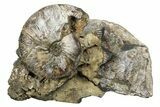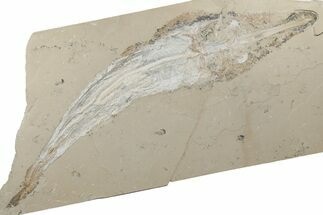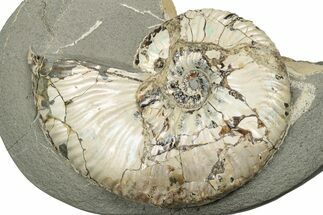4.1" Cretaceous Ammonite (Craspedodiscus) Fossil
This is a very displayable specimen of Craspedodiscus discofalcatus from the Volga River region of Russia. It has been nicely prepared from the large block of solid limestone and displays aesthetically on a flat surface. Much of this specimen has undergone pyrite replacement. Comes with an acrylic-metal display stand.
There is a repaired crack through this ammonite.
There is a repaired crack through this ammonite.
About Ammonites
Ammonites were ancient marine cephalopods, similar to today's squids and octopuses, but with a defining feature: their distinctive, tightly coiled spiral shells. These shells, resembling those of modern nautiluses, served as both a protective home and a buoyancy aid, allowing ammonites to navigate the prehistoric seas with ease. First emerging around 240 million years ago in the Triassic Period, ammonites thrived for over 175 million years, adapting through numerous forms and sizes. As predatory creatures, they likely fed on smaller marine organisms, using their tentacles to capture prey. However, their long reign came to an end 65 million years ago at the close of the Cretaceous, coinciding with the mass extinction event that also eliminated the dinosaurs.
Ammonites were ancient marine cephalopods, similar to today's squids and octopuses, but with a defining feature: their distinctive, tightly coiled spiral shells. These shells, resembling those of modern nautiluses, served as both a protective home and a buoyancy aid, allowing ammonites to navigate the prehistoric seas with ease. First emerging around 240 million years ago in the Triassic Period, ammonites thrived for over 175 million years, adapting through numerous forms and sizes. As predatory creatures, they likely fed on smaller marine organisms, using their tentacles to capture prey. However, their long reign came to an end 65 million years ago at the close of the Cretaceous, coinciding with the mass extinction event that also eliminated the dinosaurs.
$395 $275
SPECIES
Craspedodiscus discofalcatus
LOCATION
Volga River, Schilovka, Russia
SIZE
Ammonite: 4.1" wide, Entire piece: 7.65 x 5.2"
CATEGORY
SUB CATEGORY
ITEM
#243284
We guarantee the authenticity of all of our specimens.
 Reviews
Reviews












